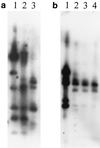Phylogenetic analysis of enteroaggregative and diffusely adherent Escherichia coli
- PMID: 10338471
- PMCID: PMC96572
- DOI: 10.1128/IAI.67.6.2692-2699.1999
Phylogenetic analysis of enteroaggregative and diffusely adherent Escherichia coli
Abstract
The phylogenetics of the various pathotypes of diarrheagenic Escherichia coli are not completely understood. In this study, we identified several plasmid and chromosomal genes in the pathogenic enteroaggregative E. coli (EAEC) prototype strain 042 and determined the prevalence of these loci among EAEC and diffusely adherent E. coli strains. The distribution of these genes is analyzed within an evolutionary framework provided by the characterization of allelic variation in housekeeping genes via multilocus enzyme electrophoresis. Our data reveal that EAEC strains are heterogeneous with respect to chromosomal and plasmid-borne genes but that the majority harbor a member of a conserved family of virulence plasmids. Comparison of plasmid and chromosomal relatedness of strains suggests clonality of chromosomal markers and a limited transfer model of plasmid distribution.
Figures



References
-
- Ausubel F M, Brent R, Kingston R E, Moore D D, Smith J A, Seidman J G, Struhl K, editors. Current protocols in molecular biology. New York, N.Y: John Wiley & Sons; 1989.
-
- Baudry B, Savarino S J, Vial P, Kaper J B, Levine M M. A sensitive and specific DNA probe to identify enteroaggregative Escherichia coli, a recently discovered diarrheal pathogen. J Infect Dis. 1990;161:1249–1251. - PubMed
-
- Bhan M K, Khoshoo V, Sommerfelt H, Raj P, Sazawal S, Srivastava R. Enteroaggregative Escherichia coli and Salmonella associated with nondysenteric persistent diarrhea. Pediatr Infect Dis J. 1989;8:499–502. - PubMed
-
- Bhan M K, Raj P, Levine M M, Kaper J B, Bhandari N, Srivastava R, Kumar R, Sazawal S. Enteroaggregative Escherichia coli associated with persistent diarrhea in a cohort of rural children in India. J Infect Dis. 1989;159:1061–1064. - PubMed
Publication types
MeSH terms
Substances
Associated data
- Actions
Grants and funding
LinkOut - more resources
Full Text Sources
Other Literature Sources

